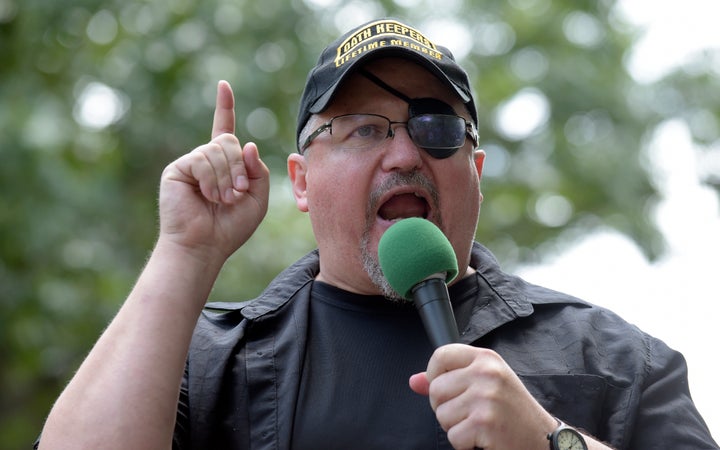WASHINGTON — The highest-profile trial to be held so far against participants in the Capitol riot got underway Monday as prosecutors began to show jurors how a group of far-right Oath Keepers plotted to stop the peaceful transfer of presidential power from Donald Trump to Joe Biden.
The Oath Keepers’ founder, Elmer Stewart Rhodes, sat alongside four others linked to the extremist group in federal court, where they are charged with seditious conspiracy against the United States.
Rhodes is expected to take the stand himself, his lawyer said.
Jeffrey Nestler, assistant U.S. attorney for the District of Columbia, used his opening statements to emphasize how Rhodes and his co-defendants ― Kelly Meggs, Kenneth Harrelson, Jessica Watkins and Thomas Caldwell ― threatened the “core democratic custom of the routine and peaceful transfer of power” observed since the country’s founding.
“These defendants tried to change that history,” Nestler said. Their philosophy, he told jurors, “perverts the Constitutional order.”
Phillip Linder, a lawyer for Rhodes, countered that while the jury “may not like” some of the things presented at trial, that did not mean they were illegal.
“The real evidence is going to show that our clients were there to do security on the 5th and 6th,” Linder said. He added: “They’re not a violent group.”
Attorneys for other defendants also significantly downplayed their clients’ roles in the riot, suggesting they were there to help others. Caldwell’s attorney said the disabled veteran “couldn’t storm his way out of a paper bag.” Watkins’ attorney said that, as a transgender woman, she didn’t feel like she fit into the group, and that “a lot of things that she did that day were to try and fit in ― good and bad.”

The charge of seditious conspiracy carries a maximum sentence of 20 years behind bars. It is rarely used — the last time the government attempted to use it was in 2010, against members of a far-right Michigan militia who were ultimately acquitted.
The government’s case against the Oath Keepers, however, appears to be a stronger one. Group text messages obtained by law enforcement illustrate the alleged planning efforts that led the Oath Keepers to arrive at a hotel outside the capital with cases full of high-powered rifles and ammunition, along with tactical gear and essential supplies to last 30 days. FBI agents found that an RV parked nearby contained grenades.
The plan, according to prosecutors, was to have the weapons within arm’s reach in the event they were able to use them on Jan. 6, 2021.
At the time, then-President Trump had incorrectly asserted that Vice President Mike Pence held the power to stop Congress from certifying Biden’s win in the 2020 presidential election. But communications show that Rhodes did not believe Pence would do anything to stop the certification. Instead, Rhodes believed Trump might invoke the Insurrection Act, an 1807 law he appeared to think would allow members of militias to intervene in order to keep Trump in power.
Nestler displayed text messages and audio recordings of Rhodes claiming that all Trump had to do was utter “Insurrection Act” and it would give the Oath Keepers “legal cover” to engage in violence. A recording of Rhodes showed him saying that Trump supporters had to prepare to “overthrow, abort or abolish Congress” by force.
“We aren’t getting through this without a civil war,” Rhodes wrote in one text message.
Several short videos from the Capitol attack played in court reminded jurors how chaotic the Jan. 6 riot was. In one of them, several of the defendants can be seen moving in a “stack” formation up to the Capitol, wearing helmets and other tactical gear.
Prosecutors allege that Rhodes was prepared for significant bloodshed. The anti-government group he founded in the wake of Barack Obama’s election was one of the most prominent involved in the Capitol attack, along with the Proud Boys, a white supremacist street gang.
Their planning allegedly began soon after it became apparent that Biden had won the 2020 election. Rhodes took part in a Signal thread with Trump adviser Roger Stone. He implored others in a different “leadership chat” on Signal that “we MUST refuse to accept Biden as a legitimate winner,” adding that they should “protect and defend all who are publicly standing against it.”
The Florida chapter of the Oath Keepers planned to hold a military-style “basic training,” which Watkins described as “mandatory” in one text message to a new recruit sent Nov. 9, 2020.
“Take the time off work in advance,” Watkins told the recruit. “I need you fighting fit by inauguration.”
The Oath Keepers, which takes its name from the oaths taken by members of the military and law enforcement, specifically aims to recruit former military and law enforcement officers as members, and several of the defendants are also veterans.
“These defendants’ narrative is that they were patriots,” Nestler said.
“They were not.”
On Jan. 6, Trump supporters descended on the Capitol at the conclusion of Trump’s so-called “Save America” rally outside the White House. As they did, Rhodes served as a “general overlooking the battlefield,” Nestler said. He was allegedly in constant communication with Oath Keepers and affiliates who stormed the building ― Meggs, Watkins and Harrelson among them. Prosecutors said that Caldwell stayed behind at the Virginia hotel with the weapons, serving in a “quick reaction force” that could rush the cache to the Capitol if needed.
Washington has strict laws regarding firearms, while Virginia does not, Nestler reminded the jurors. If the group had brought the rifles across the border into the district at the start of the day, they risked being intercepted by police, he said. The move was a “calculating” one, not a “law-abiding” one, Nestler said.
A recording of Rhodes speaking in the days after the riot showed him stating that his “only regret” was that the Oath Keepers “should have brought rifles.”
The defendants who went to the Capitol split up once inside. Watkins tried to breach the Senate chamber before getting sprayed with chemical irritants by law enforcement and backing off. Meggs, Harrelson and others tried finding House Speaker Nancy Pelosi (D-Calif.), Nestler said.
Another co-conspirator said in a text message displayed in court that he “was hoping to see Nancy’s head rolling down the front steps” of the building. Meggs responded, “We looked for her.” But they didn’t find her.
Members of Congress including Pelosi had been shepherded to safety by law enforcement during the assault of the Capitol before reconvening late that evening to finish their certification process.
The first witness of the trial, FBI Special Agent Michael Palian, was among the roughly 70 agents who showed up to protect members of Congress. He said the group walked between 80 to 85 senators through underground tunnels back to their chamber.
“I think shock would be the best word to describe what the senators were feeling at that point,” Palian recalled. “There was crying.”
Among the more alarming allegations made in the Oath Keepers’ trial is that Rhodes went to a nearby hotel midafternoon on Jan. 6 and tried to contact Trump himself. A cooperating witness said he saw Rhodes call someone close to Trump, begging to speak with him or at least pass along a message to invoke the Insurrection Act, but did not succeed.
In court on Monday, Linder said that phone call never happened.
Extremism experts told HuffPost that a successful conviction could damage the Oath Keepers, which the Anti-Defamation League estimates to be around 1,000 to 3,000 strong. But the sentiments motivating its members will remain, and other violent far-right groups at the fringe will be ready to accept new recruits.

